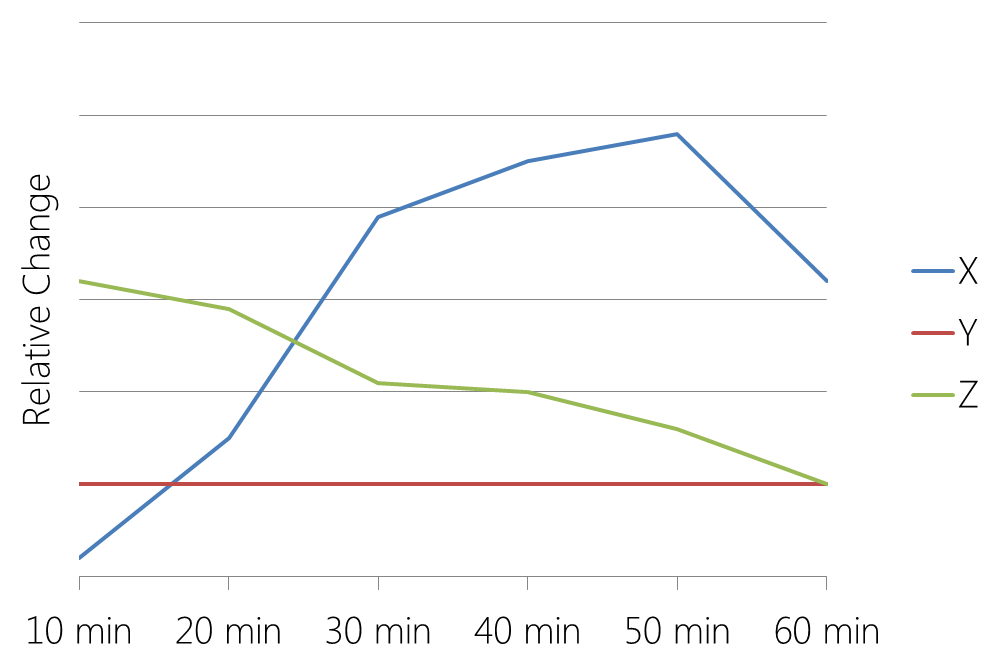WBR0808
| Author | [[PageAuthor::Yazan Daaboul, M.D. (Reviewed by Serge Korjian)]] |
|---|---|
| Exam Type | ExamType::USMLE Step 1 |
| Main Category | MainCategory::Physiology |
| Sub Category | SubCategory::Gastrointestinal |
| Prompt | [[Prompt::A researcher is studying the effect of a novel gastric inhibitory peptide (GIP) analog, GIP42, in mice. He closely follows 3 parameters X, Y following the intravenous administration of this drug. The graph below demonstrates the relative changes observed during the experiment. Based on the findings reported below, what are these parameters (X, Y, and Z) respectively? |
| Answer A | AnswerA::GI Motility, Insulin, Gastric pH |
| Answer A Explanation | AnswerAExp::GIP decreases GI motility, increases insulin secretion, and increases gastric pH by decreasing acid secretion. |
| Answer B | [[AnswerB::C-peptide, Motilin, Gastric H+]] |
| Answer B Explanation | [[AnswerBExp::GIP induces insulin secretion in a phenomenon called the "incretin effect". With increased insulin production and secretion, C-peptide, a by-product of insulin production also increases. Although GIP decreases GI motility, it is not associated with changes in motilin.]] |
| Answer C | AnswerC::Gastric pH, GI Motility, Insulin |
| Answer C Explanation | AnswerCExp::GIP increases gastric pH by decreasing acid secretion, decreases GI motility, and increases insulin secretion. |
| Answer D | AnswerD::Gastric pH, C-peptide, GI Motility |
| Answer D Explanation | AnswerDExp::GIP increases gastric pH by decreasing acid secretion, increases insulin secretion (and its byproduct C-peptide), and decreases GI motility. |
| Answer E | [[AnswerE::Insulin, Gastric H+, GI Motility]] |
| Answer E Explanation | [[AnswerEExp::GIP increases insulin secretion, decreases gastric H+, and decreases GI motility.]] |
| Right Answer | RightAnswer::B |
| Explanation | [[Explanation::Gastric inhibitory peptide (GIP), also known as glucose-dependent insulinotropic peptide is a GI hormone secreted by K cells in the duodenum and the jejunum. GIP is considered an incretin, i.e. a molecule that increases the amount of insulin released from pancreatic beta cells of the islets of Langerhans. As such, oral GIP secretion following the oral intake of fatty acid, amino acids, and glucose, leads to an "incretin effect" due to the increased secretion of insulin following release of GIP in the GI tract. The elevation in insulin levels is not seen in I.V. infusion of GIP. As a result, "incretin effect" is seen following oral GIP but not I.V. GIP, which explains the variation in plasma concentration of compound X (insulin) during each experiment. In addition to GIP, another incretin is GLP-1 (glucagon-like peptide-1) hormone. Both incretins migrate in the circulation to the beta cells of the pancreas, their target cells to stimulate insulin secretion. It has been postulated the incretin effect is defective in type 2 diabetes mellitus (T2DM); GLP-1 analogs are currently pharmacologic options for patients with T2DM. Educational Objective: GIP induces insulin secretion in a phenomenon called the "incretin effect". With increased insulin production and secretion, C-peptide, a by-product of insulin production also increases. Although GIP decreases GI motility, it is not associated with changes in motilin. |
| Approved | Approved::Yes |
| Keyword | WBRKeyword::Insulin, WBRKeyword::Incretin effect, WBRKeyword::Incretins, WBRKeyword::GLP-1, WBRKeyword::GLP, WBRKeyword::GIP, WBRKeyword::Gastric inhibitory peptide, WBRKeyword::Hormone, WBRKeyword::Glucagon, WBRKeyword::Secretin, WBRKeyword::Diabetes, WBRKeyword::Type 2 diabetes mellitus |
| Linked Question | Linked:: |
| Order in Linked Questions | LinkedOrder:: |
